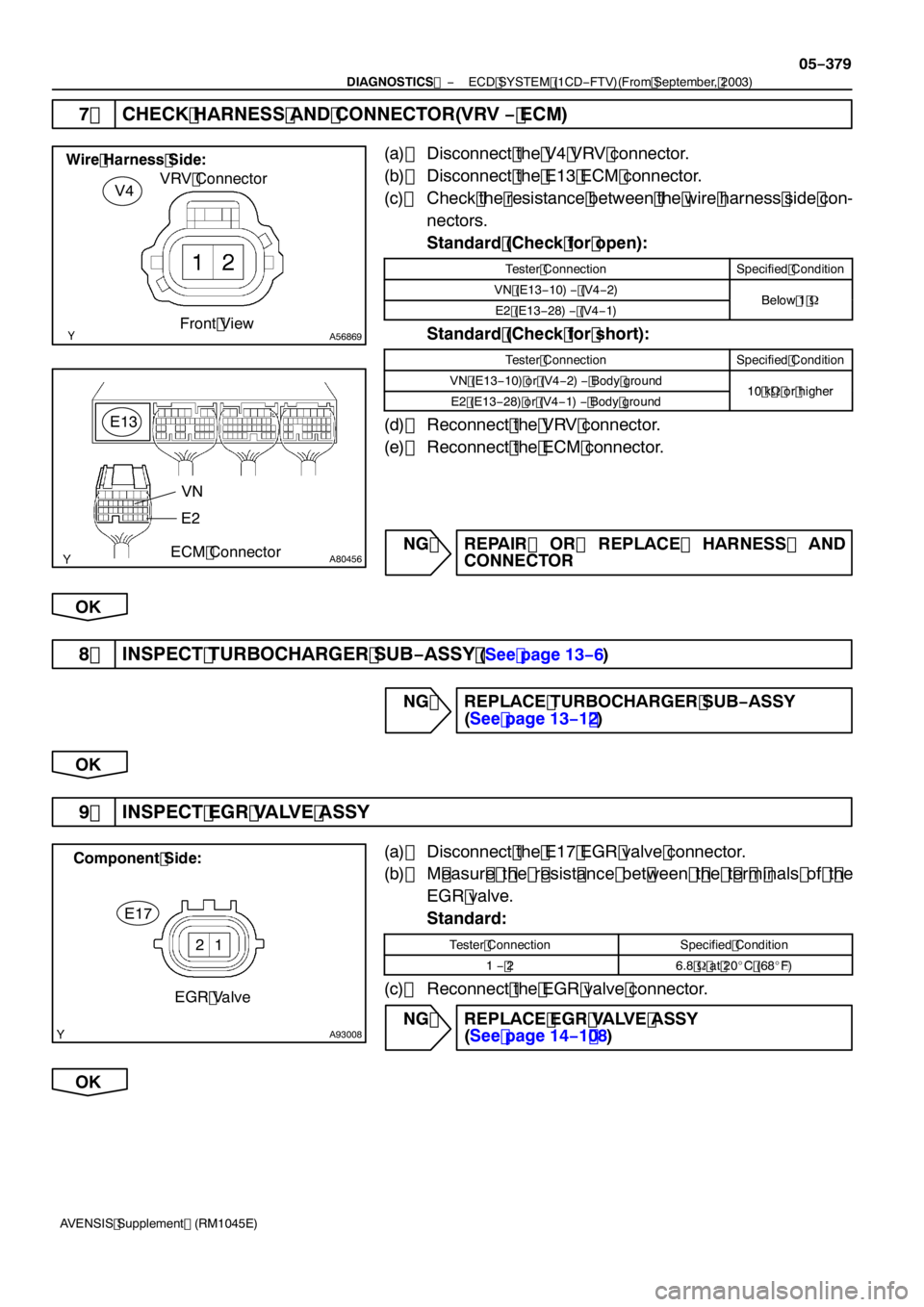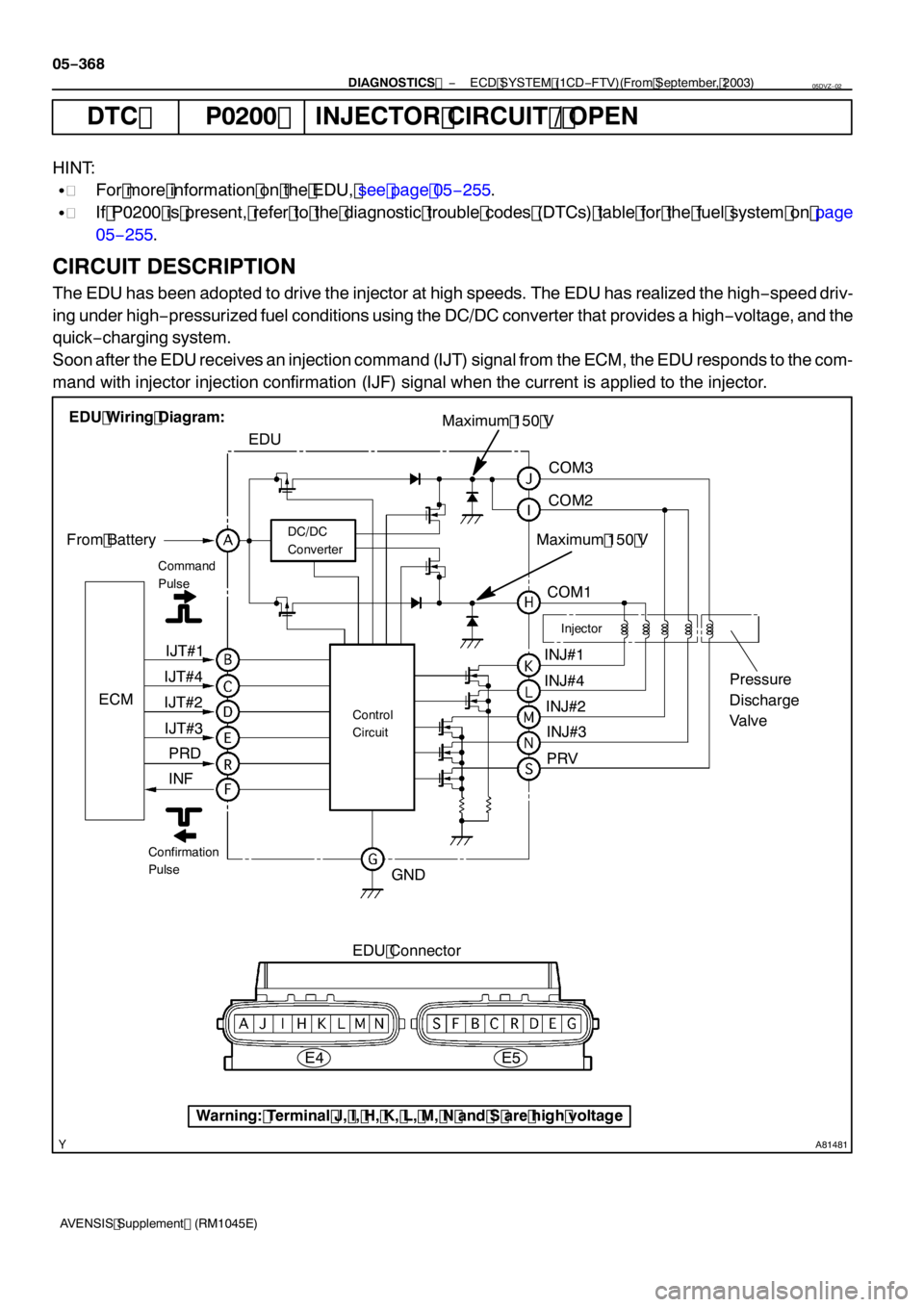Page 4244 of 5135
A66060
E13
ECM ConnectorE12
VN
E1
A05967
E
−VRV Signal Waveforms
GND
5V/
Division
1 msec./ Division
05 −378
−
DIAGNOSTICS ECD SYSTEM (1CD−FTV)(From September, 2003)
AVENSIS Supplement (RM1045E)
4 INSPECT ECM(VN VOLTAGE)
(a) Inspect using the oscilloscope.
(b) During idling, check the waveform between the specified terminals of the E12 and E13 ECM connectors.
Standard:
Tester ConnectionSpecified Condition
VN (E13 −10) − E1 (E12 −7)Correct waveform is as shown
OK REPLACE ECM (See page 10− 29)
NG
5 INSPECT VACUUM REGULATING VALVE ASSY(OPERATION) (See page 13− 8)
NG REPLACE VACUUM REGULATING VALVE ASSY
OK
6 INSPECT VACUUM REGULATING VALVE ASSY(RESISTANCE) (See page 13− 8)
NG REPLACE VACUUM REGULATING VALVE ASSY
OK
Page 4245 of 5135

A56869
V4VRV Connector
Wire Harness Side:
Front View
A80456
E13
ECM ConnectorE2
VN
A93008
EGR Valve
Component Side:
E17
1
2
−
DIAGNOSTICS ECD SYSTEM (1CD−FTV)(From September, 2003)
05 −379
AVENSIS Supplement (RM1045E)
7 CHECK HARNESS AND CONNECTOR(VRV − ECM)
(a) Disconnect the V4 VRV connector.
(b) Disconnect the E13 ECM connector.
(c) Check the resistance between the wire harness side con-
nectors.
Standard (Check for open):
Tester ConnectionSpecified Condition
VN (E13 −10) − (V4 −2)Below 1 �E2 (E13 −28) − (V4 −1)Below 1 �
Standard (Check for short):
Tester ConnectionSpecified Condition
VN (E13−10) or (V4 −2) − Body ground10 k � or higherE2 (E13 −28) or (V4 −1) − Body ground10 k � or higher
(d) Reconnect the VRV connector.
(e) Reconnect the ECM connector.
NG REPAIR OR REPLACE HARNESS AND CONNECTOR
OK
8 INSPECT TURBOCHARGER SUB −ASSY (See page 13− 6)
NG REPLACE TURBOCHARGER SUB −ASSY
(See page 13−1 2)
OK
9 INSPECT EGR VALVE ASSY
(a) Disconnect the E17 EGR valve connector.
(b) M easur e t he r esist ance bet ween t he t er m inals of t he EGR valve.
Standard:
Tester ConnectionSpecified Condition
1− 26.8 � at 20 _ C (68 _ F)
(c) Reconnect the EGR valve connector.
NG REPLACE EGR VALVE ASSY (See page 14−1 08)
OK
Page 4246 of 5135
A66060
PIM (+)
E2 (
−)
E12
ECM Connector
E13
05
−380
−
DIAGNOSTICS ECD SYSTEM (1CD−FTV)(From September, 2003)
AVENSIS Supplement (RM1045E)
1 0 CHECK AND REPLACE MANIFOLD ABSOLUTE SENSOR
(a) Turn the ignition switch to ON.
(b) Measure the voltage between the terminals of the E12
and E13 ECM connectors.
Standard:
Tester ConnectionConditionSpecified Condition
PIM (E12 −28) −
E2 (E13 −28)Applied negative pressure
of 40 kPa (300 mmHg, 11.8 in.Hg)
1.4 to 2.0 V
PIM (E12 − 28) −
E2 (E13 −28)Same as atmospheric
pressure2.0 to 2.6 V
PIM (E12 − 28) −
E2 (E13 −28)Applied positive pressure
of 69 kPa (518 mmHg, 20.4 in.Hg)
3.0 to 3.6 V
HINT:
Even if the voltage output from the manifold absolute sensor is
within the standard level, there may be a problem in the sensor
by age deterioration.
NG REPLACE MANIFOLD ABSOLUTE PRESSURE SENSOR
OK
REPLACE ECM (See page 10− 29)
Page 4247 of 5135

A81481
EDU Wiring Diagram:COM3
COM1 COM2
Pressure
Discharge
Valve
Injector
INJ#1
INJ#4INJ#2INJ#3
PRV
GND
EDU Connector
Control
Circuit
DC/DC
Converter
From Battery
IJT#1
IJT#4
IJT#2 IJT#3 PRD
INF
ECM
Maximum 150 V
Confirmation
Pulse Command
Pulse
Warning: Terminal J, I, H, K, L, M, N and S are high voltage
E4
E5
Maximum 150 V
EDU
05
−368
−
DIAGNOSTICS ECD SYSTEM (1CD−FTV)(From September, 2003)
AVENSIS Supplement (RM1045E)
DTC P0200 INJECTOR CIRCUIT / OPEN
HINT:
S For more information on the EDU, see page 05 −255.
S If P0200 is present, refer to the diagnostic trouble codes (DTCs) table for the fuel system on page
05 −255.
CIRCUIT DESCRIPTION
The EDU has been adopted to drive the injector at high speeds. The EDU has realized the high −speed driv-
ing under high −pressurized fuel conditions using the DC/DC converter that provides a high −voltage, and the
quick −charging system.
Soon after the EDU receives an injection command (IJT) signal from the ECM, the EDU responds to the com-
mand with injector injection confirmation (IJF) signal when the current is applied to the injector.
05DVZ −02
Page 4248 of 5135

A81495
Malfunction Detection:
ECMCommand Signal (IJT)
EDU
Confirmation Signal (IJF)
Injection
Command Signal
Injection
Confirmation SignalIJFON
OFF
NormalAbnormal
IJT
− DIAGNOSTICSECD SYSTEM (1CD−FTV)(From September, 2003)
05−369
AVENSIS Supplement (RM1045E)DTC No.
DTC Detection ConditionTrouble Area
P0200
SOpen or short in EDU or injector circuit
After engine is started, there is no injection confirmation (IJF)
signal from EDU to ECM, despite the ECM sending injection
command (IJT) signal to the EDU
(1 trip detection logic)SOpen or short in EDU circuit
SInjector
SEDU
SECM
MONITOR DESCRIPTION
P0200 (Open or short in EDU or injector circuit):
ECM continuously monitors both injection command (IJT) signal and injection confirmation (IJF) signal. This
DTC will be set if the ECM judges that the number of IJT signals and IJF signals are inconsistent.
The injectors are grounded over a FET (field effect transistor) and a serial resistor. This resistor creates a
voltage drop, which is monitored by the EDU, in relation to the current drawn by the injector. When the injector
current becomes too high, the voltage drop over the resistor becomes higher than a specified level and for
that injector no IJF signal is sent to the ECM.
P0200 refers to a malfunction of the injector drive circuit (EDU) or injector circuit.
If this DTC is present, the ECM enters the fail−safe mode and limits the engine power. The fail−safe mode
continues until the ignition switch is turned to OFF.
MONITOR STRATEGY
Required SensorsIJF signal from EDU
Frequency of operationContinuous
Duration10 seconds
CHK ENG Operation1 driving cycle
TYPICAL ENABLING CONDITIONS
ItemSpecificationItemMinimumMaximum
Engine speed500 rpm−
Battery voltage11 V−
Ignition switchON
Page 4249 of 5135

A81001
B−Y (RHD)
BATTECM
E102 7
IE3B−Y
10
EE17
IO1
INJF E1325
R−B
E57
IJF B−W
+B
E91
B−W 6
IK1 B−W
GR
MREL 8
GR 2
IE1 E9
Y
IREL 10 4
IE2 E9Y GR
B−WB−W
111
1 1 1 11
1 3
2 5EFI
MAIN
Relay1 3
2 5EDU
Relay
R−B
B7
EE1(LHD) (RHD)
EDU
#1 E1324
G−W
IJT#1
#2 E1323
W−R
IJT#2
#3 E1322
R−W
IJT#3
#4 E1321
W−L
IJT#4E56
E53
E52
E55
1
11 2
EFI
1A
3
3
B
FL MAIN
BatteryEngine
Room
R/B No. 1
Engine Room
R/B No. 3W−B
W−B
EC(Shielded)
D J12 E J12
E J13 D J13
BR J/CBR
W−B G
EIE48
BATTERY
E5 GND1W INJ#1
E44
12B−R I5 Injector No. 1
B
INJ#4
E43
12B−R I8 Injector No. 4
Y
INJ#2
E42
12L I6 Injector No. 2
V
INJ#3
E41
12L I7 Injector No. 3 B−R
COM1E45
L
COM2E46 BRE58
E47
COM3 BPRD E1332
R−L
E54
PRD Engine
Room
R/B No. 1
(Shielded)
D J12BRPRV 1
EA1
2
EA1 1
2W
W
B
P3
Pressure
Discharge
Valve
B−R (LHD)
B−R (LHD)
B−Y (RHD)
05−370
− DIAGNOSTICSECD SYSTEM (1CD−FTV)(From September, 2003)
AVENSIS Supplement (RM1045E)
TYPICAL MALFUNCTION THRESHOLDS
Threshold
If injection missing counter* is accumulated the specified number of times successively, or if injection missing counter for one of the
cylinders is accumulated the specified number of times successively (Approximately 1 second or more)
*: Injection missing counter increments when no IJF signal from the EDU is sent despite the ECM sending the IJT signals
WIRING DIAGRAM
Page 4250 of 5135

A81508
ECM EDU
IJT#1 INJF
COM1 INF
IJT#4
IJT#2
IJT#3 #1
#4
#2
#3INJ#1
INJ#4
INJ#2
INJ#3 COM2
Injector
AB
Warning: Terminal COM1, COM2, and INJ#1to 4 are high−voltage
C DHigh−voltage Area
A09438
#1
#2#3
#45V/
Division
20 msec./Division Signal Waveform
− DIAGNOSTICSECD SYSTEM (1CD−FTV)(From September, 2003)
05−371
AVENSIS Supplement (RM1045E)
PULSE GENERATION INSPECTION
HINT:
Problem area can be identified by checking the waveform at the following terminals.
HINT:
If you check the ECM side first, inspect the following A and D in sequence. If you check the EDU side first,
inspect the following B and C in sequence. This shortens inspecting time.
Malfunction PointTrouble Area
ASECM
B (if A is normal)SOpen or short in ”#1 to #4 (ECM)”−”IJT#1 to IJT#4 (EDU)” harness or connector
C (if A and B are normal)
SOpen or short in ”INJ#1 to INJ#4 (EDU)”−”COM1 and/or COM2” (EDU) circuit
SInjector
SEDU
D (if A, B and C are normal)SOpen or short in ”INJ (EDU)”−”INJF (ECM)” circuit (P1271 is set simultaneously)
(a) Reference: Inspection using the oscilloscope.
During idling, the correct waveform is as shown in the dia-
gram on the left.
Inspection PointsSpecified Condition
A and BCorrect waveform is as shown
Page 4251 of 5135

A81511
5V/
Division
20 msec./Division INJFSignal Waveform
05−372
− DIAGNOSTICSECD SYSTEM (1CD−FTV)(From September, 2003)
AVENSIS Supplement (RM1045E)
(b) Reference: Inspection using the oscilloscope.
During idling, the correct waveform is as shown in the dia-
gram on the left.
Inspection PointsSpecified Condition
C and DCorrect waveform is as shown
INSPECTION PROCEDURE
HINT:
SIf P0200 and P1271 are present simultaneously, there is open in the INJF wire harness between the
EDU and ECM, or there is open in the wire harness for both injector and pressure discharge valve.
SRead freeze frame data using the hand−held tester. Freeze frame data records the engine conditions
when a malfunction is detected. When troubleshooting, freeze frame data can help determine if the
vehicle was running or stopped, if the engine was warmed up or not, if the air−fuel ratio was lean or
rich, and other data from the time the malfunction occurred.
1CHECK OTHER DTC OUTPUT(IN ADDTION TO DTC P0200)
(a) Connect the hand−held tester to the DLC3.
(b) Turn the ignition switch to ON and turn the hand−held tester ON.
(c) Select the item ”DIAGNOSIS / OBD/MOBD / DTC INFO / CURRENT CODES”.
(d) Read DTCs.
Result:
Display (DTC output)Proceed to
P0200 and P1238A
P0200B
B Go to step 3
A
2 READ VALUE OF HAND−HELD TESTER(COMPENSATION OF INJECTION
VOLUME BETWEEN CYLINDERS)
(a) Connect the hand−held tester to the DLC3.
(b) Turn the ignition switch to ON and turn the hand−held tester ON.
(c) Start the engine.
(d) Select the item ”DIAGNOSIS / OBD/MOBD / DATA LIST / ALL / INJ VOLUME FB” and read its value
displayed on the hand−held tester.
Result:
ResultCompensatory Injection Volume (mm3)
Standard−3to3
Maximum−4.9 to 4.9
(e) Inspect and repair the cylinder that has an improper compensation value according to the following
steps.
GO